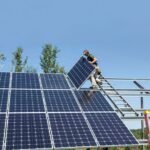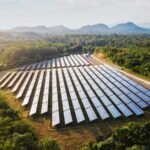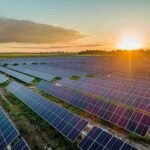Design Guide for High-Wind Resistant PV Structures (up to 250 km/h)
Date: March 2025
Anti-Cyclone Solar Mounting System
This document outlines the engineering and design considerations required for developing a solar PV mounting system capable of withstanding extreme wind speeds of up to 250 km/h (≈ 70 m/s). The aim is to ensure structural integrity, performance reliability, and long-term durability in high-risk cyclone or hurricane-prone regions.
Wind Pressure Estimation
The dynamic wind pressure (q) is calculated using the standard formula:
q = 0.613 × V² (in Pascals), where V is wind speed in m/s.
For V = 70 m/s (≈ 250 km/h):
q = 0.613 × 70² = 3003.7 Pa
This pressure value must be used as a minimum design reference across all structural and anchoring components.
PV Module Selection Criteria
- Use certified high-wind load modules (minimum front load rating of ≥ 5400 Pa) with test certification under IEC 61215 & IEC 61730.
- Frame material: Anodized aluminum with reinforced corners
- Avoid glass-backsheet configurations; prefer double-glass modules if possible.
Mounting Structure Design
4.1 Structural Configuration
- Type: Fixed-tilt structure with low-profile aerodynamic design
- Recommended tilt angle: ≤ 15 degrees for minimal wind drag
- Span between supports: Maximum 1.8 meters to avoid vibration or flexing
4.2 Material Specifications
- Hot-dip galvanized steel or marine-grade aluminum (6005-T5) for all structural elements
- Corrosion resistance in compliance with ISO 9223: C4 or higher
- Fasteners: Stainless steel A4 (316) with locking nuts and torque-tested assembly
4.3 Aerodynamic Enhancements
- Use wind deflectors or side skirts to reduce uplift forces
- Incorporate rounded or tapered edges to minimize vortex shedding
Foundation System Design
5.1 Foundation Type
- Recommended: Driven steel pile foundation (minimum embedment: 2.0 – 2.5 meters)
OR
- Reinforced concrete footing with anchor bolts and shear plates
5.2 Anchor System
- Use high-strength chemical anchors or cast-in-place anchor bolts (Grade 8.8 or higher)
- Minimum pull-out strength per anchor: ≥ 20 kN
- Edge distance and embedment per ACI 318 & Eurocode 2
5.3 Soil-Structure Interface
- Require geotechnical investigation to determine soil bearing capacity, water table depth, and seismic category
- Apply safety factor ≥ 1.5 for all foundation loads
⸻
Installation Guidelines
- Perform torque verification on all bolts after 48 hours of initial installation
- Use vibration-dampening washers between module frame and support rails
- All metallic interfaces to be electrically bonded and grounded
- Cables should be routed through UV-stable conduits with wind-rated fasteners
Testing and Validation
- Wind tunnel testing or CFD simulations are strongly recommended for validating layout and structure in high-wind scenarios.
- Optional: Real-time vibration monitoring sensors for post-installation performance tracking.
⸻
Maintenance and Inspection
- Schedule bi-annual inspections to check fasteners, corrosion, tilt stability, and module anchorage
- After any major wind event (>120 km/h), conduct a full mechanical inspection
⸻
Compliance and Standards
All components and design methodologies should adhere to the following international standards:
- ASCE 7-22 – Minimum Design Loads for Buildings and Other Structures
- IEC 62817 – Mechanical design for PV structures
- ASTM A123 / A153 – Zinc coating for corrosion resistance
- ISO 1461 – Hot-dip galvanized coatings
- EN 1991-1-4 – Eurocode for wind actions
Summary
By implementing this Anti-Cyclone Solar Mounting System, the PV installation will be engineered to withstand extreme wind events up to 250 km/h. The design focuses on:
- Aerodynamic optimization
- Heavy-duty anchoring
- Certified materials and fasteners
- Engineering based on proven global standards
This system ensures maximum reliability, safety, and investment protection in the most demanding environmental conditions.
read more:
- EPCF Model Explained: Transforming Solar Energy Projects in Emerging Markets
- How To Become A Trusted Global Supplier?
Meta Questions and Answers:
- 1. What is the maximum wind speed the Anti-Cyclone Solar Mounting System is designed for?
The system is engineered to resist wind speeds up to 250 km/h (approximately 70 m/s), equivalent to dynamic wind pressure of over 3000 Pa. - 2. What materials are recommended for the mounting structure?
The design specifies hot-dip galvanized steel or marine-grade aluminum (6005-T5), with stainless steel A4 (316) fasteners for corrosion resistance and strength. - 3. How is uplift force reduced in high-wind PV designs?
Aerodynamic features like wind deflectors, low tilt angles (≤15°), side skirts, and rounded edges help reduce uplift and vortex effects. - 4. What type of foundation is most suitable for cyclone-prone regions?
Driven steel pile foundations with a minimum embedment of 2.0–2.5 meters or reinforced concrete footings with high-strength anchors are recommended. - 5. What standards govern the structural design of this system?
The guide aligns with international codes including ASCE 7-22, IEC 62817, EN 1991-1-4 (Eurocode), and ISO 1461 for structural and corrosion resistance compliance.








